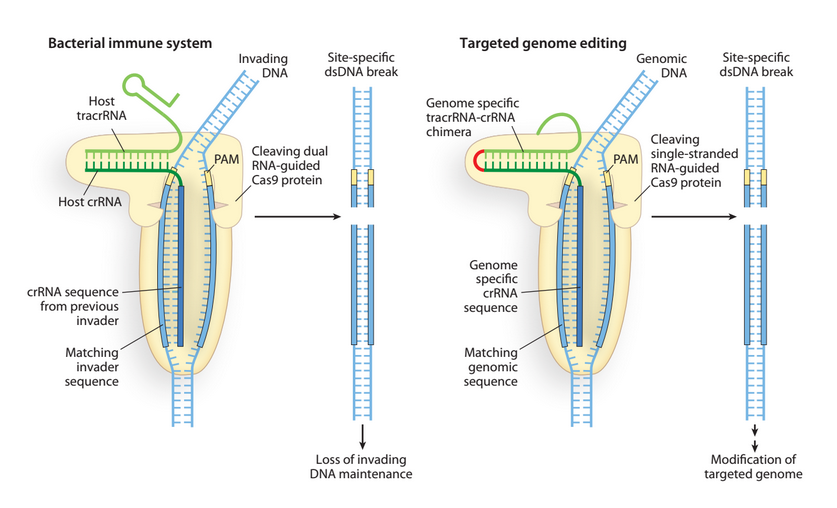CRISPR/Cas9, a gene-editing technique that can target and modify DNA with groundbreaking accuracy, is both the newest darling and the newest villain of genetics research.
Invented in 2012 by scientists at the University of California, Berkeley, CRISPR/Cas9 has received a lot of attention this year. Not only are scientists publishing reports on the technique at breakneck speed (at 370 mentions in research publications so far this year, that’s a rate of 20 papers a week), but it also seems that each piece of news that comes out about CRISPR/Cas9 is grander and juicier than the last.
Videos by VICE
In the past two weeks alone, scientists have announced that they have used the new technology to inhibit hepatitis C in human cells and to defy Mendel’s laws of inheritance, which have governed the field of genetics for over a century.
That’s not to mention recent, highly-publicized attempts to eradicate a disease-causing gene in human embryos, which were met with limited success. The experiment, which constituted the first time scientists have reported trying to genetically engineer humans at the reproductive level, triggered concerns from an international community of scientists and ethicists. (Protein & Cell, the journal that published the results of the experiment, released a statement yesterday defending their decision to publish the controversial study as a cautionary example.)
Today, the National Institutes of Health definitively stated that they will not fund any use of gene-editing technologies in human embryos, citing safety and ethical concerns, as well as a current lack of medical applications that would justify the use of CRISPR/Cas9 over existing technologies.
Here’s the thing: CRISPR/Cas9 wasn’t invented yesterday. It has existed as a gene-editing technique for three years, and scientists have been investigating CRISPR in bacteria for much longer—since the 1980s. Like an actor who guest-appeared on some TV sitcoms and then suddenly landed multiple Hollywood roles, CRISPR appeared on the world stage slowly at first, and then all at once.
Since 2012, research on CRISPR/Cas9 technology has ramped up—with no obvious end in sight. Now, CRISPR/Cas9 research has reached the point where scientists are urgently considering how the technology will fit into the future of humankind.
What is CRISPR-Cas9?
Scientists in Japan were the first to discover CRISPR in the DNA of bacteria in 1987. In their attempts to study a particular protein-encoding gene in E.Coli, the researchers noticed a pattern of short, repeating, palindromic DNA sequences separated by short, non-repeating, “spacer” DNA sequences.
Over the next five years, researchers realized that these repeats were present in many bacteria and other single-celled organisms. In 2012, scientists coined the term CRISPR, short for “clustered regularly interspaced short palindromic repeats,” to describe the pattern.
For another decade, scientists hammered out the details of CRISPR. They figured out that the repeating DNA patterns, along with a family of “Cas” (CRISPR-associated) proteins and specialized RNA molecules, play a role in bacterial immune systems. They deemed the entire complex of DNA repeats, Cas proteins, and RNA molecules as the CRISPR/Cas system.

Here’s how CRISPR/Cas works in bacteria: When bacteria encounter an invading source of DNA, such as from a virus, they can copy and incorporate segments of the foreign DNA into their genome as “spacers” between the short DNA repeats in CRISPR.
These spacers enhance the bacteria’s immune response by providing a template for RNA molecules to quickly identify and target the same DNA sequence in the event of future viral infections. If the RNA molecules recognize an incoming sequence of foreign DNA, they guide the CRISPR complex to that sequence. There, the bacteria’s Cas proteins, which are specialized for cutting DNA, splice and disable the invading gene.
In the fall of 2012, a team of researchers led by UC Berkeley scientists Jennifer Doudna and Emmanuelle Charpentier announced that they had hijacked the bacteria’s CRISPR/Cas immune system to create a new gene-editing tool. Their CRISPR/Cas9 system involved CRISPR, a Cas protein called Cas9, and hybrid RNA that could be programmed to identify, cut, and even replace any gene sequence. By the start of 2013, research applying CRISPR/Cas9 to genetic engineering was underway.
What’s new about all this?
CRISPR’s main advantage over its gene-editing predecessors, zinc finger nucleases and TALENS, is that it is extremely easy to use. Zinc finger nucleases and TALENS both require that scientists create custom proteins for each DNA target — a process that requires much more effort than the painless RNA programming required for CRISPR.
CRISPR can also be used in seemingly any type of cell. Researchers have reported success using CRISPR/Cas9 in animal embryos, including those of mice, frogs, and monkeys, as well as human stem and immune cells.

A diagram comparing how CRISPR works in the bacterial immune system and how it works in CRISPR/Cas9 genome editing. Image by H. Adam Steinberg, artforscience.com.
Over the past two years, researchers have explored many different applications of CRISPR/Cas9, including genetically modifying crops, eradicating viruses, screening for cancer genes, and—the subject of much recent debate—genome engineering. They’ve also introduced a number of techniques to reduce the number of mutations created at unintended sites, an error called off-targeting.
What’s next?
These building successes led some to think about the next step for CRISPR/Cas9: engineering inherited genes in humans. Early last month, rumors started circulating that a study on the use of CRISPR/Cas9 in human embryos would soon be published. The predictions came true last week with the publication of the controversial Protein & Cell paper from researchers at Sun Yat-sen University in Guangdong, China.
In conversations both preceding and following the Sun Yat-sen paper’s publication, scientists have disagreed over a critical point: whether or not researchers should even be starting to look into CRISPR/Cas9 in the human reproductive line. This question, and clashing degrees of audacity surrounding its answer, sits at the center of CRISPR/Cas9’s recent media ascension.
Experts are concerned about CRISPR/Cas9 in human germ cells (which include eggs, sperm and embryos) for several reasons. Many feel that there are still too many unknowns about CRISPR/Cas9. Researchers can’t reliably predict when and how often off-targeting occurs, for instance. Beyond the effectiveness of the technique itself, there are ethical considerations, such as how to deal with altering the genetic material of future generations without their consent.
Other scientists, however, feel that the time to start assessing the safety and efficacy of CRISPR/Cas9 in human germ cells is now.
If scientists are able to nail down the use of CRISPR/Cas9 in human germ cells, there’s no question that it could confer major benefits. Namely, the technology could eradicate hereditary diseases such as cystic fibrosis, sickle-cell anemia, and Huntington’s disease from a family line altogether.
It’s also necessary, however, to consider another logical conclusion—that people might want to use gene-editing techniques to create humans with super strength, hyper-intelligence, or whatever other genetic traits people might desire. For good reason, such possibilities trigger fears of eugenics and designer babies.
These weighty implications (as well as a charged, ongoing patent battle over who owns the technology) ensure that conversations around CRISPR/Cas9 will continue. Already, there are several CRISPR/Cas9 conferences planned for the next year.
For now, answers to the big scientific and philosophical questions around CRISPR/Cas9 may remain unknown. What does seem clear, however, is that we are hurtling towards a future in which CRISPR/Cas9 almost certainly will have a starring role.



